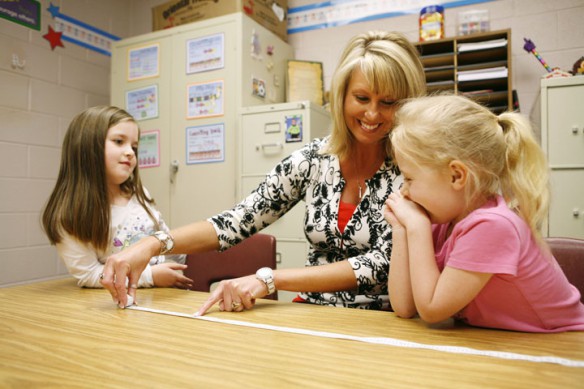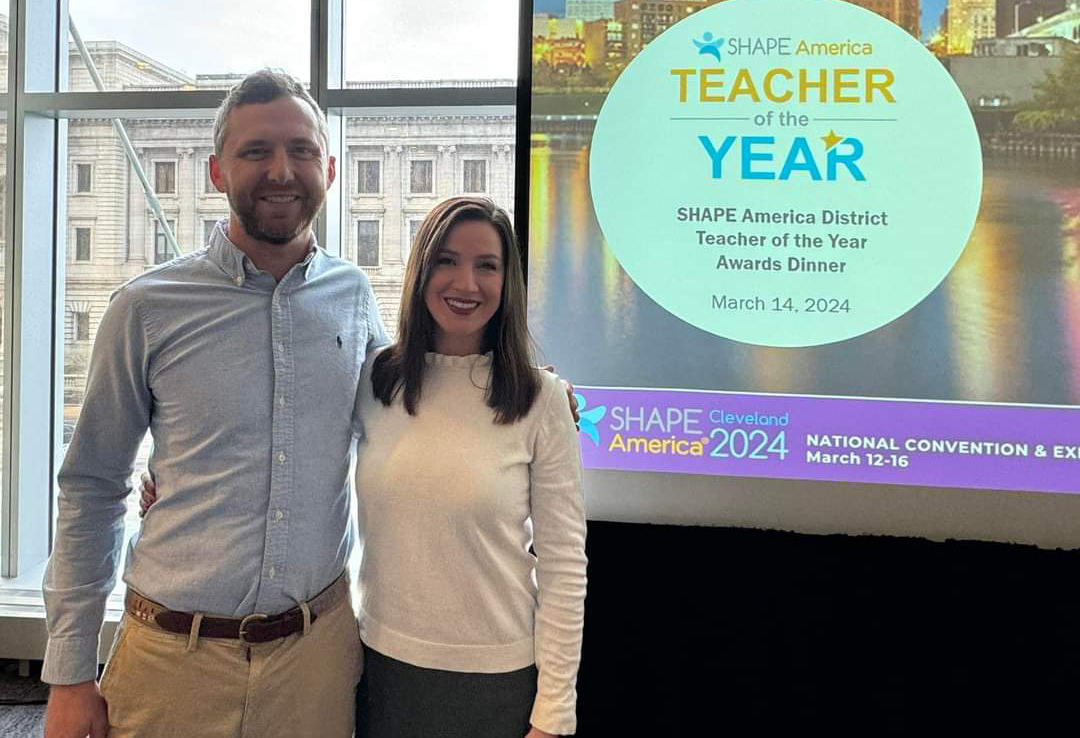
Math intervention specialist Suzanne Maynard works on a number line with kindergarten students Makylie Morris and Makenna Fletcher at Southside Elementary School (Pike County). Photo by Amy Wallot, April 10, 2012
By Susan Riddell
susan.riddell@education.ky.gov
Southside Elementary School (Pike County) Principal Jill Maynard has been at her school since it first opened its doors 15 years ago. In that time, she’s seen many changes. One thing that hasn’t changed, however, is the family feel of the school.
“We are blessed to have such a unique family,” said Maynard, who is finishing up her first year as the school’s principal. “Our administration, faculty and staff believe we must create an atmosphere of mutual respect where students and teachers are involved in the learning process. We believe that all students will succeed, and we work diligently each day to accomplish this success.”
Southside Elementary was rewarded for its diligent work when the school was named a 2011 National Blue Ribbon School along with four other Kentucky public schools.
Suzanne Maynard (no relation) has been at Southside Elementary since the school opened. She currently serves as the school’s mathematics intervention teacher, focusing on K-3 mathematics. She said another constant has been academic success.
“We have always maintained high standardized test scores,” Suzanne Maynard said. “Teachers have clear learning targets with high expectations for all students.”
In 2010, 47 percent of Southside Elementary students were proficient and 50 percent were distinguished in reading on the Kentucky Core Content Test. That’s compared to 62 percent proficient in reading and 28 percent distinguished in 2006. That trend continued in mathematics. In 2006, the proficient/distinguished ratio was 51/15 percent, and by 2010, it was 15/81 percent proficient/distinguished.
“The biggest key to our success is the fact that we truly care about our kids, and we’re committed to doing whatever it takes to help them succeed,” said 3rd-grade teacher Nickie Blackburn. “That usually translated into longer hours, differentiated lesson plans, more parent conferences and extra work with students every day at planning. We really do believe that all children can learn, and we make every effort to see that they do.”
Even with success in recent mathematics scores, Southside Elementary has looked to fine tune its mathematics instruction with Everyday Math. Students in grades K-5 are using the curriculum with daily 90-minute lessons, integrated technology applications and a home link for parent communication, Suzanne Maynard said.
“In addition, we have a math grant through the Mathematics Achievement Fund,” she said. “It incorporates strategies from math recovery using a program called Add + Vantage Math Recovery. It is used with our response to intervention program in math with at risk students.
“It has provided intense professional development with assessments and instructional strategies to differentiate instruction to meet the needs of students,” Suzanne Maynard added.
Other initiatives have really paid off at the school, said Jill Maynard, who raved about Southside Elementary’s professional learning communities (PLCs) and other collaborative efforts.
“I feel that the implementation of PLCs at each grade level has had a great impact on our school because we are continuously improving student achievement by increasing the learning capacity of building staff,” Jill Maynard said. “The PLC is composed of collaborative teams whose members work interdependently each week to achieve goals. The teams share a common understanding that learning, not teaching, is the central purpose of school.
“After common core standards have been taught, teachers develop and administer common assessments,” she added. “At this point, they determine ways to work together to address the gaps and continually track student progress.”
Blackburn said teacher collaboration at Southside Elementary happens continuously.
“During common planning, over the phone, after school,” she said. “We prepare lesson plans together, discuss student progress and bounce ideas off each other. It’s so very helpful to have other grade level teachers to go to for help.
“Also, our special needs teachers are always a wonderful resource when we need them. A child doesn’t have to be in special needs for them to be able to give us wonderful advice on how to help the student,” Blackburn added.
Southside Elementary, a 2011 National Title I Distinguished School, also is focused on getting its students college- and/or career-ready.
“Like other elementary schools, we are following the common core standards to ensure that our students are college- and/or career-ready,” Jill Maynard said. “Our students have guest speakers representing a variety of career choices. Our students visit various community helpers such as the fire department and the post office. In addition, our students participate in variety of activities that will equip them with real-life skills.”
One of those activities is Market Day.
Students in Christy McCoy’s 3rd-grade class participate in Market Day each October in conjunction with an economics unit.
“Each child determines if they want to create a product to sell, or they can provide a service,” McCoy said. “This allows them to be producers, service workers and consumers in the mini society. This connects them to the ‘real world.’”
Students must name their business and create signs for it. They determine costs for products (hair bows, balloon animals, name tags) or services (hair braiding, tattoos, face painting). Instead of real money, $tar Buck$ are used. McCoy said students learn about profit, loss and competition during this part of the project.
During Market Day, students use their $tar Buck$ to pay for rented space for their shop, utilities and staff to watch the store while they shop at other locations and buy other students’ products and services.
“At the end, we hold an auction which is usually where children get rid of most of their money,” McCoy said.
“When our economics unit of study is finished, each child is asked to do a reflection sheet about the event,” McCoy added. “This is when they use many learned vocabulary words stating what types of natural, capital and human resources they used to complete their task.
“The part of the program that works best for me is how driven the children are to learn and how fun it makes the learning,” McCoy added. “Just this year, my students mastered more than 30 economics terms, and they can tell you what each one is and cite an example. They become producers, consumers and service workers in this society. “
MORE INFO …
Jill Maynard, jill.maynard@pike.kyschools.us, (606) 353-7296











Leave A Comment